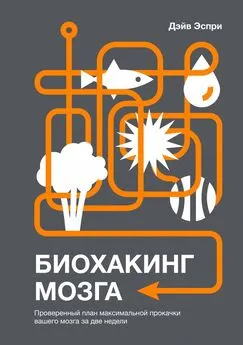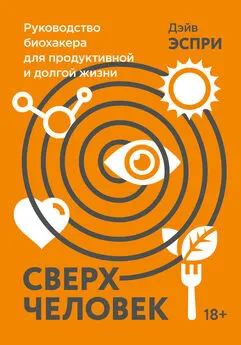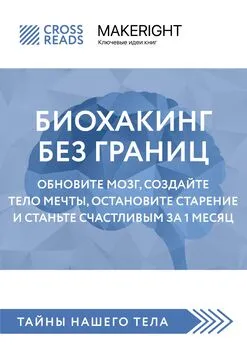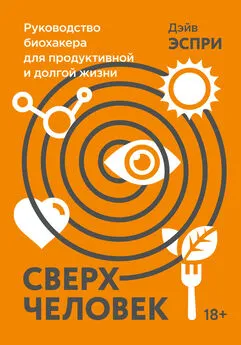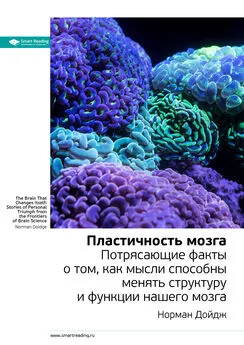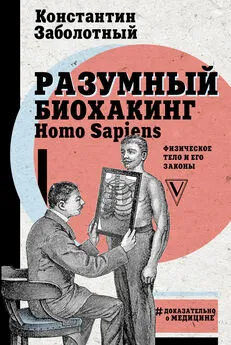Дэйв Эспри - Биохакинг мозга
- Название:Биохакинг мозга
- Автор:
- Жанр:
- Издательство:Манн, Иванов и Фербер
- Год:2018
- Город:Москва
- ISBN:9785001176312
- Рейтинг:
- Избранное:Добавить в избранное
-
Отзывы:
-
Ваша оценка:
Дэйв Эспри - Биохакинг мозга краткое содержание
Представили?
Это реально. В этой книге вы найдете эффективную программу прокачки организма. Вы узнаете, какие продукты должны присутствовать в вашем рационе и каких следует избегать, какие виды физической активности необходимо добавить в распорядок дня, как правильно организовать рабочее пространство, а еще о добавках, детоксе для дома и тела, медитации и дыхательных практиках, позволяющих мозгу всего за две недели заработать на все 100 %.
Биохакинг мозга - читать онлайн бесплатно ознакомительный отрывок
Интервал:
Закладка:
Sultan Ayoub Meo et al., “Association of Exposure to Radio-Frequency Electromagnetic Field Radiation (RF-EMFR) Generated by Mobile Phone Base Stations with Glycated Hemoglobin (HbA1c) and Risk of Type 2 Diabetes Mellitus,” International Journal of Environmental Research and Public Health 12, no. 11 (November 2015): 14519–14528, DOI: 10.3390/ijerph121114519.
268
Howard H. Carter et al., “Cardiovascular Responses to Water Immersion in Humans: Impact on Cerebral Perfusion,” American Journal of Physiology. Regulatory, Integrative and Comparative Physiology 306, no. 9 (May 2014): R636–640, DOI: 10.1152/ajpregu.00516.2013.
269
Бреус, Майкл. Всегда вовремя. Узнайте свой хронотип и живите в согласии со своим биоритмом.М.: Манн, Иванов и Фербер, 2017. Прим. ред.
270
Howard H. Carter et al., “Cardiovascular Responses to Water Immersion in Humans: Impact on Cerebral Perfusion,” American Journal of Physiology. Regulatory, Integrative and Comparative Physiology 306, no. 9 (May 2014): R636–640, DOI: 10.1152/ajpregu.00516.2013.
271
Gabriel S. Chiu et al., “Hypoxia/Reoxygenation Impairs Memory Formation via Adenosine-Dependent Activation of Caspase 1,” Journal of Neuroscience: The Official Journal of the Society for Neuroscience 32, no. 40 (October 3, 2012): 13945–13955, DOI: 10.1523/JNEUROSCI.0704-12.2012.
272
R. C. Loopstra-Masters et al., “Associations between the Intake of Caffeinated and Decaffeinated Coffee and Measures of Insulin Sensitivity and Beta Cell Function,” Diabetologia 54, no. 2 (February 2011): 320–328, DOI: 10.1007/s00125-010-1957-8.
273
Salome A. Rebello et al., “Coffee and Tea Consumption in Relation to Inflammation and Basal Glucose Metabolism in a Multi-Ethnic Asian Population: A Cross-Sectional Study,” Nutrition Journal 10 (June 2, 2011): 61, DOI: 10.1186/1475-2891-10-61.
274
Andrew M. James et al., “Interactions of Mitochondria-Targeted and Untargeted Ubiquinones with the Mitochondrial Respiratory Chain and Reactive Oxygen Species,” Journal of Biological Chemistry 280, no. 22 (June 3, 2005): 21295–312, DOI: 10.1074/jbc.M501527200.
275
Dana E. King et al., “Dietary Magnesium and C-Reactive Protein Levels,” Journal of the American College of Nutrition 24, no. 3 (June 2005): 166–171.
276
Kevin A. Feeney et al., “Daily Magnesium Fluxes Regulate Cellular Timekeeping and Energy Balance,” Nature 532, no. 7599 (April 21, 2016): 375–379, DOI: 10.1038/nature17407.
277
Sean R. Hosein, “Can Vitamin D Increase Testosterone Concentrations in Men?” CATIE — Canada’s Source for HIV and Hepatitis C Information, September 2011, http://www.catie.ca/en/treatmentupdate/treatmentupdate-185/nutrition/can-vitamin-increase-testosterone-concentrations-men.
278
Pietro Ameri et al., “Interactions between Vitamin D and IGF-I: From Physiology to Clinical Practice,” Clinical Endocrinology 79, no. 4 (October 2013): 457–63, DOI: 10.1111/cen.12268.
279
Akash Sinha, “Shining Some Light on the Powerhouse of the Cell — Is There a Link between Vitamin D and Mitochondrial Function in Humans?” (Conference abstract, Canadian Pediatric Endocrine Group Annual Meeting, Montréal, QC, February 22, 2014).
280
Caroline Rae et al., “Oral Creatine Monohydrate Supplementation Improves Brain Performance: A Double-Blind, Placebo-Controlled, Crossover Trial.,” Proceedings of the Royal Society B: Biological Sciences 270, no. 1529 (October 22, 2003): 2147–2150, DOI: 10.1098/rspb.2003.2492.
281
Alexander M. Wolf et al., “Astaxanthin Protects Mitochondrial Redox State and Functional Integrity against Oxidative Stress,” Journal of Nutritional Biochemistry 21, no. 5 (May 2010): 381–389, DOI: 10.1016/j.jnutbio.2009.01.011.
282
U. Justesen, P. Knuthsen, and T. Leth, “Determination of Plant Polyphenols in Danish Foodstuffs by HPLC-UV and LC-MS Detection,” Cancer Letters 114, no. 1–2 (March 19, 1997): 165–167.
283
http://umm.edu/health/medical/altmed/herb/green-tea.
284
D. O. Kim et al., “Sweet and Sour Cherry Phenolics and Their Protective Effects on Neuronal Cells,” Journal of Agricultural and Food Chemistry 53 (2005): 9921–9927.
285
Tiffany Greco and Gary Fiskum, “Brain Mitochondria from Rats Treated with Sulforaphane Are Resistant to Redox-Regulated Permeability Transition,” Journal of Bioenergetics and Biomembranes 42, no. 6 (December 2010): 491–497, DOI: 10.1007/s10863-010-9312-9.
286
J. M. Haslam and H. A. Krebs, “The Permeability of Mitochondria to Oxaloacetate and Malate,” Biochemical Journal 107, no. 5 (May 1968): 659–667; B. S. Meldrum, “Glutamate as a Neurotransmitter in the Brain: Review of Physiology and Pathology,” Journal of Nutrition 130, no. 4S Suppl. (April 2000): 1007S–1015S.
287
Cameron Rink et al., “Oxygen-Inducible Glutamate Oxaloacetate Transaminase as Protective Switch Transforming Neurotoxic Glutamate to Metabolic Fuel during Acute Ischemic Stroke,” Antioxidants and Redox Signaling 14, no. 10 (May 15, 2011): 1777–1785, DOI: 10.1089/ars.2011.3930.
288
Francisco Campos et al., “Blood Levels of Glutamate Oxaloacetate Transaminase Are More Strongly Associated with Good Outcome in Acute Ischaemic Stroke Than Glutamate Pyruvate Transaminase Levels,” Clinical Science 121, no. 1 (July 2011): 11–17, DOI: 10.1042/CS20100427.
289
M. Yudkoff et al., “Brain Amino Acid Metabolism and Ketosis,” Journal of Neuroscience Research 66, no. 2 (October 15, 2001): 272–281, DOI: 10.1002/jnr.1221John P. M. Wood and Neville N. Osborne, “Zinc and Energy Requirements in Induction of Oxidative Stress to Retinal Pigmented Epithelial Cells,” Neurochemical Research 28, no. 10 (October 2003): 1525–1533.
290
J. D. Johnson, D. J. Creighton, and M. R. Lambert, “Stereochemistry and Function of Oxaloacetate Keto-Enol Tautomerase,” Journal of Biological Chemistry 261, no. 10 (April 5, 1986): 4535–4541.
291
Montserrat Marí et al., “Mitochondrial Glutathione, a Key Survival Antioxidant,” Antioxidants and Redox Signaling 11, no. 11 (November 2009): 2685–2700, DOI: 10.1089/ARS.2009.2695.
292
K. A. Bauerly et al., “Pyrroloquinoline Quinone Nutritional Status Alters Lysine Metabolism and Modulates Mitochondrial DNA Content in the Mouse and Rat,” Biochimica et Biophysica Acta 1760, no. 11 (November 2006): 1741–1748, DOI: 10.1016/j.bbagen.2006.07.009.
293
Calliandra B. Harris et al., “Dietary Pyrroloquinoline Quinone (PQQ) Alters Indicators of Inflammation and Mitochondrial-Related Metabolism in Human Subjects,” Journal of Nutritional Biochemistry 24, no. 12 (December 2013): 2076–2084, DOI: 10.1016/j.jnutbio.2013.07.008.
294
Kathryn Bauerly et al., “Altering Pyrroloquinoline Quinone Nutritional Status Modulates Mitochondrial, Lipid, and Energy Metabolism in Rats,” PLOS ONE 6, no. 7 (July 21, 2011), DOI: 10.1371/journal.pone.0021779.
295
Kei Ohwada et al., “Pyrroloquinoline Quinone (PQQ) Prevents Cognitive Deficit Caused by Oxidative Stress in Rats,” Journal of Clinical Biochemistry and Nutrition 42, no. 1 (January 2008): 29–34, DOI: 10.3164/jcbn.2008005.
296
M. Costanzo et al., “Low Ozone Concentrations Stimulate Cytoskeletal Organization, Mitochondrial Activity and Nuclear Transcription,” European Journal of Histochemistry 59, no. 2 (April 21, 2015), DOI: 10.4081/ejh.2015.2515.
297
Oliver Tucha and Klaus W. Lange, “Effects of Nicotine Chewing Gum on a Real-Life Motor Task: A Kinematic Analysis of Handwriting Movements in Smokers and Non-Smokers,” Psychopharmacology 173, no. 1–2 (April 2004): 49–56, DOI: 10.1007/s00213-003-1690-9.
298
R. J. West and M. J. Jarvis, “Effects of Nicotine on Finger Tapping Rate in Non-Smokers,” Pharmacology, Biochemistry, and Behavior 25, no. 4 (October 1986): 727–731.
299
G. Mancuso et al., “Effects of Nicotine Administered via a Transdermal Delivery System on Vigilance: A Repeated Measure Study,” Psychopharmacology 142, no. 1 (n.d.): 18–23, DOI: 10.1007/s002130050857.
300
A. C. Parrott and G. Winder, “Nicotine Chewing Gum (2 Mg, 4 Mg) and Cigarette Smoking: Comparative Effects upon Vigilance and Heart Rate,” Psychopharmacology 97, no. 2 (1989): 257–261.
301
S. Phillips and P. Fox, “An Investigation into the Effects of Nicotine Gum on Short-Term Memory,” Psychopharmacology 140, no. 4 (December 1998): 429–433; F. Joseph McClernon, David G. Gilbert, and Robert Radtke, “Effects of Transdermal Nicotine on Lateralized Identification and Memory Interference,” Human Psychopharmacology 18, no. 5 (July 2003): 339–343, DOI: 10.1002/hup.488.; D. V. Poltavski and T. Petros, “Effects of Transdermal Nicotine on Prose Memory and Attention in Smokers and Nonsmokers,” Physiology and Behavior 83, no. 5 (January 17, 2005): 833–843, DOI: 10.1016/j.physbeh.2004.10.005.
302
Maryka Quik et al., “Chronic Oral Nicotine Normalizes Dopamine Function and Synaptic Plasticity in 1-Methyl-4-Phenyl-1,2,3,6-Tetrahydropyridine-Lesioned Primates,” Journal of Neuroscience 26, no. 17 (April 26, 2006): 4681–4689, DOI: 10.1523/JNEUROSCI.0215-06.2006.
303
David Nutt et al., “Development of a Rational Scale to Assess the Harm of Drugs of Potential Misuse,” Lancet 369, no. 9566 (March 2007): 1047–1053, DOI: 10.1016/S0140-6736(07)60464-4.
304
William K. K. Wu and Chi Hin Cho, “The Pharmacological Actions of Nicotine on the Gastrointestinal Tract,” Journal of Pharmacological Sciences 94, no. 4 (April 2004): 348–358.
305
Rebecca Davis et al., “Nicotine Promotes Tumor Growth and Metastasis in Mouse Models of Lung Cancer,” PLOS ONE 4, no. 10 (October 20, 2009), DOI: 10.1371/journal.pone.0007524.
306
Hani Atamna et al., “Methylene Blue Delays Cellular Senescence and Enhances Key Mitochondrial Biochemical Pathways,” FASEB Journal 22, no. 3 (March 2008): 703–712, DOI: 10.1096/fj.07-9610com.
307
David J Bonda et al., “Novel Therapeutics for Alzheimer’s Disease: An Update,” Current Opinion in Drug Discovery and Development 13, no. 2 (March 2010): 235–246.
308
Narriman Lee Callaway et al., “Methylene Blue Improves Brain Oxidative Metabolism and Memory Retention in Rats,” Pharmacology, Biochemistry, and Behavior 77, no. 1 (January 2004): 175–181.
309
Pavel Rodriguez et al., “Multimodal Randomized Functional MR Imaging of the Effects of Methylene Blue in the Human Brain,” Radiology 281, no. 2 (June 28, 2016): 516–526, DOI: 10.1148/radiol.2016152893.
Читать дальшеИнтервал:
Закладка:
